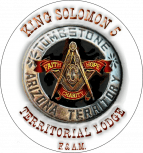King Solomon Lodge No. 5 Territorial Lodge, Free and Accepted Masons (F&AM)
A Continuing Legacy Since 1881 of Fraternal Brotherhood & Honor
We are proudly located in “rootin’ tootin’ shootin'” Tombstone, Arizona!
Lodge is held in historic Schieffelin Hall and has been holding lodge there since 1881.
Established on June 4th, 1881 as SOLOMON Lodge F&AM under Dispensation by the Grand Master of the Grand Lodge of F&AM of California.
Chartered on March 25th, 1882 as KING SOLOMON Lodge No. 5 F&AM by the Grand Lodge of F&AM of the Territory of Arizona.
Officially named KING SOLOMON LODGE No. 5, TERRITORIAL LODGE, F&AM of Arizona under the Grand Lodge of F&AM of Arizona.
1881
Was a year of prosperity and turmoil in Tombstone. Miners, prospectors, ranchers, miners and business people from all walks of life were drawn to this western boomtown just grasping for the chance to become wealthy. The streets were a chaos of people, horses, carriages, wagons and supplies all heading into and out of the town.
Miners were hauling loads of rich ore up from the shafts that zigzagged underneath the bustling streets above. Ranchers and cattlemen were spreading their herds out over the high desert and business people were establishing a foundation that supported everyone’s efforts, and made them good money.
In February, Cochise County was established with Tombstone as its county seat. In March, outlaws attempted to rob approximately $26,000 in silver bullion on a stagecoach en-route to Benson, setting the stage for the gunfight at the OK Corral on October 26.
Ms. Nancy Lewis Sosa, Tombstone Historical Researcher, informed the Lodge that there is strong evidence to believe the hold-up may have been a ruse to commit an assassination in an attempt to murder the newly elected Sheriff of Pima County.
Sheriff-elect Bob Paul was acting at the time as the shotgun messenger on the ill-fated stagecoach. The recent election was hotly contested and allegations abounded about fraud.
For example, San Simon district had ten eligible voters but recorded 103 ballets cast for Charles A. Shibell and one lone vote for Bob Paul. Shibell was supported by a loosely organized federation of outlaw cowboys, mostly Southerners, who also strongly opposed the Earps. That election changed alliances and increased tensions between the cowboys and the Earps, which led up to the notorious Gunfight at the OK Corral.
At the same time a group of prominent citizens, all Freemasons, was gathering to lay the foundation for a fraternal organization that would outlast all the hustle and bustle swirling about them.
On Monday evening, March 14, 1881, twenty-seven Master Masons, including ten from different states and two from Scotland, met at the Pima County Bank in Tombstone at the corner of 4th and Allen Streets in a First Preliminary Meeting, to find a way to establish a Masonic Lodge.
It was going to be no easy task. One of many hurdles was to obtain a dispensation from the Grand Lodge of California. Wells Spicer was elected chairman to manage and oversee the effort while Thomas R. Sorin was appointed as secretary.
Wells W. Spicer (1831-1885) was an eccentric, but likable fellow. He worked as a journalist, prospector and a politician, but his career as a lawyer and a judge was what brought him fame in two consequential events; his part in the defense his part in the defense involved in the Mountain Meadows Massacre in the Utah Territory (1857) and, later on as the judge in the hearing of the Earps and Doc Holiday: for their part in the Gunfight at the O.K. Corral (1881).
After lengthy discussions among the Freemasons regarding the hurdles surrounding the establishment of a new lodge, they finally settled on pursuing a request for dispensation from the Grand Lodge of California.
It was sent to the Grand Master of California bearing the names of those fifteen Master Masons, and in addition, twelve other Masons who desired to assist in establishing a new lodge in Tombstone, Territory of Arizona.
The petitioners requested King Solomon as the name for the lodge. However, the Grand Lodge of California already had a King Solomon Lodge on their rolls; thus, the dispensation was issued in the name of Solomon Lodge, Under Dispensation (UD). The petition was granted and the dispensation took effect on June 4, 1881.


The Grand Master, Most Worshipful Brother Samuel C. Denson appointed Brother Wells Spicer as the Master of the lodge, Brother Benjamin Titus, the Senior Warden and Brother Thomas R. Sorin, the Junior Warden.
As the dispensation was issued by the Grand Master during recess of the Grand Lodge, it was only valid until the next meeting of the Grand Lodge in October 1881. At that time the charter was denied and the dispensation returned with all necessary documentation in order required to obtain a charter. However, the dispensation was extended until October 1, 1882.
Apparently the Lodge was not solvent at that time, at least, to the liking of the Grand Lodge of California. The group approached Arizona a Lodge No. 257 — now Arizona No. 2 in Phoenix — and was recommended by the Master of that Lodge as being proficient in the various arts and sciences necessary to permit them to open and govern a well-regulated lodge.
Thus, twenty-seven Masons were listed as members of Solomon Lodge in the dispensation.
